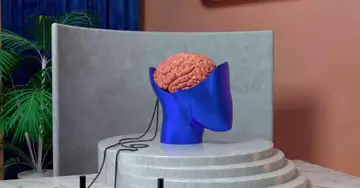In the world of visual art, there are many "gatekeepers." A few - an elite group of curators, collectors, and tastemakers - have the power to decide what art we should value. Society has largely accepted this imbalance as the default, as physical and economic constraints have prevented most people from meaningfully participating in this ecosystem for centuries.
The metaverse is a paradigm shift away from this reality. Galleries, exhibitions, and museums that were once constrained by limitations such as scheduling, fundraising, and the logistics of physically managing artworks can now expand their presence in infinite ways.
Harold Eytan is CEO of Particle. This article is part of "Metaverse Week.
Digital curators can produce more exhibitions and respond to important cultural trends and events in real time. And artists and collectors can now share spaces, collaborate and exchange ideas about art in virtual environments from anywhere in the world. Virtual reality (VR) headsets allow people to transcend geographic boundaries and fully immerse themselves in a digital place.
One example is the Museum of Crypto Art (MoCA), a virtual museum in Somnium Space. The virtual museum, co-founded by Pablo Rodriguez-Fraile, a major digital art collector, and designed by Desiree Casoni, collects tokenized artworks acquired as non-fungible tokens (NFT).
MoCA's artworks are accessible to anyone with an internet connection. And because NFT ownership is validated on the blockchain, the museum can expand access without diluting the monetary value of the works. Indeed, Rodriguez-Fraile could make a case for why NFTs have value.
With virtually none of the traditional costs of a physical gallery, designers and curators can make exhibitions as imaginative and immersive as they wish, spending less time and capital.
The same is true for architects, who are limited only by their imaginations when designing in the metaverse. There are no longer spatial constraints or cost barriers when it comes to creating transformative, other-worldly experiences.
For museums, this means that each work of art could have its own form-fitting building - or even its own world - where the message and character of the work is commented upon or amplified by its living and infinitely dynamic environment.
The metaverse enables art creators to create experiences in entirely new dimensions. What might art feel like on the moon? At the center of a black hole? Or, to return to reality: Metaverses like Somnium Space allow curators to take into account the changing seasons and times of day.
Interaction with physical art will never go away, of course - nor should it. There's nothing quite like being in the presence of a true masterpiece. But the Metaverse allows us to extrapolate that magic and expand access to a wider range of art enthusiasts.
This newfound access is especially important. As new generations spend more and more time online, museums and galleries are constantly looking for new ways to bring their historic collections to a wider audience.
Curators know that art is more than just aesthetics and material - it represents a moment in time and conveys past eras through a perceptual lens that teaches us who we were and who we can be.
As traditional art spaces struggle to maintain consistent attendance, the metaverse offers these cultural institutions the opportunity to revive past worlds for a digital audience.
But how do we navigate ownership in a world where everything is accessible? Profile picture collections (PFPs) have popularized NFTs by giving an identity to a digital artwork that can be monetized in its original form. What if we applied the same concepts to the great masterpieces of art?
Even more revolutionary than the metaverse's expanded access and new forms of experience is the blockchain's ability to authenticate art. The physical art world is opaque, and it can be difficult to prove provenance - even for masterpieces. However, blockchain protocols can make prices and ownership transparent and even divide them among many owners.
In the past, most people could never own a Banksy - or any of the works that fetch millions of dollars at auction houses. By transferring the value of a physical good to the blockchain and creating a legal structure that supports this transformation, we can effectively fractionate masterpieces and make them accessible to a much larger population.
Broader ownership will create a new generation of art collectors, spark greater interest in fine art, and create myriad token-gating opportunities that foster connections and community.
One of the great inconsistencies in the visual art world is that its mechanisms often do not reflect the ethos of the artists themselves. Does Banksy make art in the hope that a select few will elevate his name to the pantheon of art so that his works can sell for millions of dollars to very wealthy individuals? Did Basquiat? Or Frida Kahlo? Probably not.
The Metaverse expands access and introduces new ownership models, bringing art closer to people - and to the human condition that inspired art in the first place.
More from Metaverse Week:href="https://www.coindesk.com/layer2/metaverseweek/2022/05/23/how-the-metaverse-could-be-a-game-changer-for-nft-gaming/">How the Metaverse could change the game for NFT gamingRather than allowing players to port weapons or powers between games, non-fungible tokens will serve as building blocks for new games and virtual worlds
. The Metaverse Will Make Gamers of Us All Essentially,the "Metaverse" is a game - but one with real-world consequences and possibilities
. What can you do in the Metaverse in 2022?The future possibilities of the Metaverse are probably limitless, but is there anything you can do in the Metaverse right now?
Rather than allowing players to port weapons or powers between games, non-fungible tokens will serve as building blocks for new games and virtual worlds
. The Metaverse Will Make Gamers of Us All Essentially,the "Metaverse" is a game - but one with real-world consequences and possibilities
. What can you do in the Metaverse in 2022?The future possibilities of the Metaverse are probably limitless, but is there anything you can do in the Metaverse right now?

